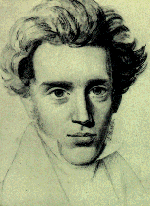Copyright 1998 by Tad Beckman, Harvey Mudd College
![]()

Soren Kierkegaard was born on May 5, 1813, in Copenhagen. His mother and father were both religious people; and Kierkegaard was both baptized and confirmed, at the age of fifteen, in Heilligeist Church. After registering in the University of Copenhagen in October 1830, Kierkegaard completed both parts of his examinations by October 1831. In the autumn of 1837, he began teaching Latin in Borgerdydskolen, the school which he himself had attended.
Kierkegaard met a young woman, Regine Olsen, in May of 1837. This relationship was to become the dominating experience of his life. He proposed marriage to Regine in September , 1840, and successfully became engaged. Kierkegaard's father had died in 1838; and in 1840, he passed the examination for a degree in theology. By November of that year, he entered the Pastoral Seminary. And by September of 1841, he submitted and defended his dissertation for the equivalent of a doctor of divinity degree.
In August, 1841, Kierkegaard had returned Regine's engagement ring; and by October the engagement was officially ended. Two years later, Regine became engaged to Fridrich Schlegel; and in November 1847, Regine and Fridrich were married. Kierkegaard began a pattern of travels back-and-forth between Copenhagen and Berlin. While he remained actively in the study of theology and preached, he was never ordained as such. Instead, at this point in his life, Kierkegaard began a strangely schizophrenic pattern of authorship. He wrote relatively traaditional Christian texts under his own name; but he also wrote critical treatises under a variety of pseudonyms. He even wrote attacks against himself under various names. Either/Or and Fear and Trembling, two of his most famous works, were both published in 1843. "A Literary Review," which included "The Present Age," was published in 1846. Kierkegaard died on November 11, 1855, at 42. He had been prolific throughout his adult life.
Crucial in Kierkegaard's creative life was an idealization of religious experience, or practice, and a complementary distaste for the structure and attitudes of 19th Century industrial society, as it was growing up around him. Somehow, his own love life, centering around Regine as it did, became the most hurtful case-in-point. 19th Century institutions, religious ones in particular, became offensive to him. Nothing was authentic; everything had closed itself to the authentic past, like Judas to Christ. Note particularly, in "The Present Age," how Kierkegaard dwells on the lack of passion evidenced by society around him and how, instead, everything has to be rationally calculated and under control.
Sources: Soren Kierkegaard WebSite at http://www.webcom.com/kierke/ and Kaufmann, Walter. "Introduction" in The Present Age by Soren Kierkegaard (Harper & Row, 1962).
![]()
Return to course notes contents.
![]()